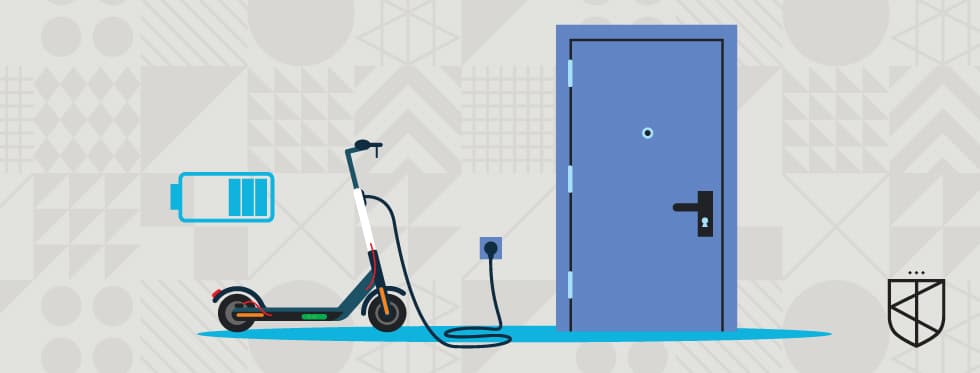
You may be hearing a lot about lithium-ion batteries after some recent media coverage about fires caused by eBikes or scooters. While the risks are serious, there is no need to panic. These fires are rare, and often exacerbated by poor charging practices, or low-quality products.
Read on to learn more about these fires, some simple steps you can take to mitigate the risks if you own one of these devices, and what to look out for if you’re in the market for one.
What is a lithium-ion battery?
As the name suggests, it is a battery powered by lithium ions – a very light metal, with a very high energy density (meaning a lot of energy is stored per unit volume of the battery) Because of this, it’s the most common type of battery for many household items such as phones, laptops, power tools and appliances. More recently, it has been gaining attention due to its use in the increasingly popular eBikes and eScooters.
The downside, however, is that due to their high amount of energy in a small space, when they fail, they can also release a large amount of energy, creating toxic fumes, explosions and flames.
Why are lithium fires so bad?
Lithium-ion battery fires can be intense, long-lasting and even toxic. Once a fire starts, it can produce jet like flames, and it is not just smoke being released, but dangerous gases such as carbon monoxide, hydrogen fluoride and hydrogen chloride. These noxious gases are particularly dangerous in confined spaces. Further, lithium fires can sometimes have a chemical reaction when they come into contact with water. Instead of putting out a lithium fire, water can actually fuel one.
Should I be worried?
The risks are serious, and you should be aware of them, but again, there’s no need to panic. If treating, storing and charging your (quality) devices properly there is no reason to assume they will catch fire. That being said, caution is always advised.
Follow the below steps to minimise your risk and the likelihood of experiencing one of these fires yourself.
1. Only use reputable and quality products.
Well manufactured, good quality batteries, chargers and products will be less likely to catch fire. Where possible, only purchase products from reputable, well established brands. Often, these higher quality devices will have in-built heat management systems which can reduce the likelihood of the ‘thermal runaway’ which causes fires.
When purchasing secondhand goods, be sure to monitor for signs of wear which may indicate damage to the battery, such as dints, cracks or bulges.
2. Practise safe charging.
It’s easy to slip into unsafe habits when using devices with lithium-ion batteries. For example, charging devices on beds, blankets or carpets, or leaving devices on charge when you are out, or asleep.
Batteries should always be charged on a hard surface, and while attended.
You should not charge a battery that shows any signs of damage or is hot to the touch. It is not recommended to leave devices containing lithium batteries where they may get wet or hot, such as in the sun or in a car.
Finally, and most importantly, do not charge any device in a hallway or doorway that could block your exit if there were a fire.
3. Be safety aware.
Knowing now what these fires are like, and how they are caused, take notice of your devices.
If you notice overheating, swelling, leaking or unusual sounds, stop using the product. If you see smoke, flames or a vapour cloud, call 000 immediately.
And finally, never throw lithium-ion batteries in your waste or recycling bins. Besides being poor waste management and bad for the environment, it is not safe. Bins are often susceptible to heat or rain, and the contents susceptible to damage – many battery-related fires start in bins and waste disposal areas.
For those living in strata dwellings, it is worth being extra cautious. Apart from the health and safety risks and the potential damage to your property in the event of a fire, living in close proximity to others also poses the risk of endangering and causing damage to your neighbours. Don’t be afraid to have this conversation in your community to help keep everyone safe.
Last updated February 2024. This article is for reference purposes only and is not intended to be a comprehensive review of the developments in the law and practice or to cover all aspects of the subject matter. It does not constitute legal or other advice and should not be relied upon this way. Readers should take legal or other advice before applying the information containing in this publication.


